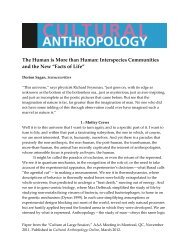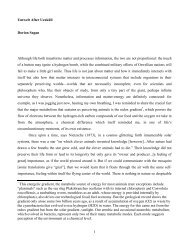PESTICIDES IN COCA-COLA AND PEPSI - Cultural Anthropology
PESTICIDES IN COCA-COLA AND PEPSI - Cultural Anthropology
PESTICIDES IN COCA-COLA AND PEPSI - Cultural Anthropology
Create successful ePaper yourself
Turn your PDF publications into a flip-book with our unique Google optimized e-Paper software.
CULTURAL ANTHROPOLOGY 22:4<br />
664<br />
activities (Agrawal and Narain 1991). The Coca-Cola–Pepsi campaign is of a piece<br />
with one of the earliest issues taken up by CSE, namely global warming and the<br />
injustice inherent in the demand of the developed countries for the imposition<br />
of caps on greenhouse gas emissions by the developing countries. The position<br />
on global warming attests to its international orientation and sensitivity to the<br />
structural inequities of the global political economy. Environmental organizations<br />
such as Greenpeace play a bridging role between the concerns of the affected local<br />
communities and global environmental discourses centered on issues such as<br />
biosafety and public health, and entailing conceptions of accountability in governance,<br />
transparency, sustainability, and efficiency (Hindu 2005a, 2005b). Similarly,<br />
the business practices of The Coca-Cola Company in India, and elsewhere, have<br />
come under increased scrutiny, internationally, from networks of environmental<br />
and human rights groups. After the adverse impacts of Coca-Cola plants on the<br />
environment—especially groundwater overexploitation and the effects on local<br />
communities—became widely known, a number of U.S. universities responded by<br />
banning Coca-Cola products on their campuses. 4 The increasing enmeshing of environmental<br />
and broadly “civic” (Chatterjee 2004) concerns has led to the blurring<br />
of the boundary between various environmentalisms and their seemingly divergent<br />
objectives. One of the results has been the increased embededness of environmental<br />
NGOs in international networks of donors and supporters, thus leading to the mobilization<br />
of significant resources, and providing visibility and legitimacy to these<br />
issues.<br />
Another outcome has been that the role of the environmental NGOs is increasingly<br />
to translate what would be local concerns related to sectional interests—often<br />
pertaining to minorities, albeit affluent ones—into an environmental vocabulary<br />
with universalist claims. The sense of environmental entitlement is often expressed<br />
in the language of rights, such as, the “right to clean air,” which in turn is grounded<br />
in the scientistic discourse of individual risk and public health. What is elided in this<br />
discourse is the disproportionate burden borne by the working poor for enforcing<br />
these “environmental rights” on the behalf of affluent minorities. Therefore, in their<br />
discursive construction of the environment as a site for consumption, the new environmentalism<br />
effaces production and producers—an ideological sleight-of-hand<br />
it shares with much of the neoliberal dogma. 5 Middle-class environmental organizations,<br />
unable to mobilize and sustain broad coalitions, have thus increasingly<br />
resorted to the use of courts in coaxing an apathetic state to action, a strategy<br />
that has been well documented to lead to outcomes congruent with middle-class<br />
interests (Greenough 2006).






